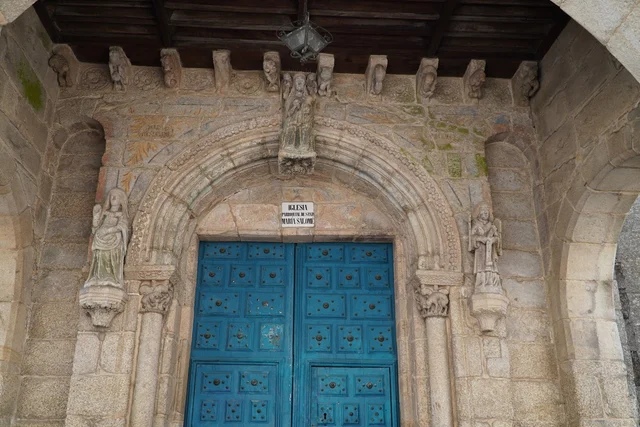Beyond and Upwards: Santiago de Compostela
- STU
- Aug 6
- 4 min read
The rain fell steadily as we approached the cathedral's towering spires, each drop seeming to wash away something we didn't know we were carrying. Santiago de Compostela revealed itself not in sunshine and postcard moments, but through the gray mist of a Galician afternoon. And somehow, that felt exactly right.
"Ultreia et Suseia," called a fellow traveler as we passed, staff in hand, scallop shell gleaming wet against her backpack. Beyond and upwards. The ancient greeting of pilgrims carries more weight than its simple translation suggests. It's both encouragement and recognition—an acknowledgment that we're all walking toward something higher, whether we've journeyed 500 miles or just stepped off a bus.

The Language of Pilgrimage
Every symbol here tells a story. The scallop shell, worn by pilgrims for over a thousand years, points the way like a compass rose, its ridged lines converging toward a single destination, much like the countless paths that lead to this cathedral square. Walking sticks lean against café walls and church doors, silent witnesses to journeys both physical and spiritual. These aren't just props for photos; they're tools of transformation, carrying the weight of steps taken and burdens released.
Inside the cathedral, the botafumeiro—the world's largest incense burner—swings in magnificent arcs, trailing clouds of frankincense. Originally used to mask the odors of unwashed pilgrims, it now serves a different purpose: lifting prayers and intentions skyward, a physical manifestation of that eternal human desire to reach beyond ourselves.

During holy years, when St. James's feast day falls on a Sunday, the cathedral's Holy Door opens, a portal reserved for pilgrims seeking not just forgiveness, but renewal. Even in ordinary years, crossing the threshold feels significant. You sense the millions who've passed this way before, each carrying their own hopes and hurts.
Campo de Estrellas
The name Santiago de Compostela itself means "field of stars" reportedly where a hermit saw celestial lights revealing the apostle's tomb. Standing in the cathedral square at dusk, you understand the metaphor. This isn't just about astronomy; it's about finding light in darkness, direction when you're lost, hope when the way forward seems unclear.
"Buen Camino," strangers say in passing, good way. It's more than pleasantry; it's recognition. Whether you've walked the Camino Francés from France, the coastal Camino del Norte, the Camino Portugués from Porto, or dusty from the road to Andalucía, with car full of luggage and plans for southern Spain—you're part of something larger. The greeting acknowledges that we're all pilgrims in some sense, all seeking our own version of beyond and upwards.
Nourishment for Body and Soul
The journey transforms you, but so does the destination. In Santiago's narrow stone streets, Michelin-starred restaurants like A Tafona serve modern interpretations of ancient Galician recipes, while Casa Marcelo fuses local traditions with Japanese and Peruvian influences. Even the act of eating becomes pilgrimage; nourishing both body and spirit, connecting us to place and tradition.
The rain that accompanied our visit became part of the experience rather than despite it. It drummed against medieval stones, filled ancient gutters, and reminded us that some of life's most profound moments come not in perfect conditions, but in surrendering to what is.
Finding Your Field of Stars
John Muir understood something essential: "Everyone needs places to play in and pray in, where nature may heal and give strength to body and soul alike." Santiago de Compostela is such a place, not because it's particularly beautiful (though it is), or convenient (it's decidedly not), but because it holds space for the universal human need to journey toward something greater than ourselves.
You don't need to walk 500 miles to find your own field of stars. Sometimes it's enough to recognize that we're all walking some version of the Camino. Seeking meaning, carrying burdens, hoping for transformation. The pilgrimage begins not with the first step on an ancient path, but with the recognition that the journey itself might be the destination.
In difficult times especially, we need reminders that there are still places where strangers wish each other "Buen Camino" (good way) and mean it. Places where rain becomes blessing, where walking sticks become companions, and where the simple act of moving forward becomes a form of prayer.
Ultreia et Suseia. Beyond and upwards. The greeting echoes long after you've left Santiago's cobblestones behind, a reminder that the pilgrimage continues wherever you are, one step at a time.
Igrexa de Santa María Salomé: This church, built in the 12th century, is believed to be the only church in Spain dedicated to Saint Mary Salome, the mother of Saint James the Greater and St. John the Evangelist, one of the ‘Three Marys’ and one of the companions of Jesus during his Calvary and burial.
____________________
P.S. Time moves differently in Santiago. The Jacobean Holy Years follow their own rhythm—arriving every 6, 5, 6, and 11 years in an ancient cycle that feels both mathematical and mystical. The next Xacobeo begins in 2027, when that emblematic Holy Door—the Porta Santa tucked behind the cathedral in Plaza de Quintana—will open on December 31st, 2026. Until then, it waits, sealed and patient, holding space for future pilgrims and their own journeys toward the light.
















Comments